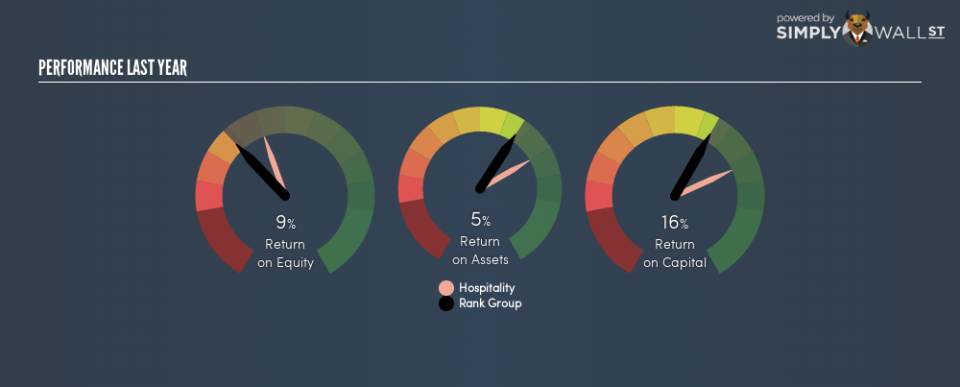The Rank Group Plc (LON:RNK) Earns A Nice Return On Capital Employed

Today we’ll evaluate The Rank Group Plc (LON:RNK) to determine whether it could have potential as an investment idea. Specifically, we’re going to calculate its Return On Capital Employed (ROCE), in the hopes of getting some insight into the business.
Firstly, we’ll go over how we calculate ROCE. Second, we’ll look at its ROCE compared to similar companies. Finally, we’ll look at how its current liabilities affect its ROCE.
Understanding Return On Capital Employed (ROCE)
ROCE measures the ‘return’ (pre-tax profit) a company generates from capital employed in its business. In general, businesses with a higher ROCE are usually better quality. Overall, it is a valuable metric that has its flaws. Renowned investment researcher Michael Mauboussin has suggested that a high ROCE can indicate that ‘one dollar invested in the company generates value of more than one dollar’.
How Do You Calculate Return On Capital Employed?
The formula for calculating the return on capital employed is:
Return on Capital Employed = Earnings Before Interest and Tax (EBIT) ÷ (Total Assets – Current Liabilities)
Or for Rank Group:
0.16 = UK£77m ÷ (UK£720m – UK£226m) (Based on the trailing twelve months to June 2018.)
So, Rank Group has an ROCE of 16%.
View our latest analysis for Rank Group
Want to help shape the future of investing tools and platforms? Take the survey and be part of one of the most advanced studies of stock market investors to date.
Does Rank Group Have A Good ROCE?
One way to assess ROCE is to compare similar companies. In our analysis, Rank Group’s ROCE is meaningfully higher than the 8.6% average in the Hospitality industry. We consider this a positive sign, because it suggests it uses capital more efficiently than similar companies. Independently of how Rank Group compares to its industry, its ROCE in absolute terms appears decent, and the company may be worthy of closer investigation.
When considering this metric, keep in mind that it is backwards looking, and not necessarily predictive. ROCE can be misleading for companies in cyclical industries, with returns looking impressive during the boom times, but very weak during the busts. This is because ROCE only looks at one year, instead of considering returns across a whole cycle. Since the future is so important for investors, you should check out our free report on analyst forecasts for Rank Group.
How Rank Group’s Current Liabilities Impact Its ROCE
Liabilities, such as supplier bills and bank overdrafts, are referred to as current liabilities if they need to be paid within 12 months. Due to the way the ROCE equation works, having large bills due in the near term can make it look as though a company has less capital employed, and thus a higher ROCE than usual. To counter this, investors can check if a company has high current liabilities relative to total assets.
Rank Group has total liabilities of UK£226m and total assets of UK£720m. Therefore its current liabilities are equivalent to approximately 31% of its total assets. Rank Group has a middling amount of current liabilities, increasing its ROCE somewhat.
The Bottom Line On Rank Group’s ROCE
Rank Group’s ROCE does look good, but the level of current liabilities also contribute to that. Of course, you might find a fantastic investment by looking at a few good candidates. So take a peek at this free list of companies with modest (or no) debt, trading on a P/E below 20.
If you are like me, then you will not want to miss this free list of growing companies that insiders are buying.
To help readers see past the short term volatility of the financial market, we aim to bring you a long-term focused research analysis purely driven by fundamental data. Note that our analysis does not factor in the latest price-sensitive company announcements.
The author is an independent contributor and at the time of publication had no position in the stocks mentioned. For errors that warrant correction please contact the editor at editorial-team@simplywallst.com.

 Yahoo Finance
Yahoo Finance 